Cyberbullying Among School Children: A Problem Analysis for BUS101
VerifiedAdded on 2020/09/08
|7
|1590
|34
Homework Assignment
AI Summary
This assignment presents a problem analysis of cyberbullying among school children, structured around the 4Ps framework: Present Situation, Problem, Possible Solutions, and Proposal. The analysis begins by outlining the current prevalence of cyberbullying, particularly in Australia, highlighting the increasing use of social media platforms and the rising rates of victimization among students. The problem section delves into the psychological and social impacts of cyberbullying, including aggression, depression, and academic difficulties. It also underscores the role of Facebook as a common platform for bullying. The possible solutions section proposes various strategies, such as empowering victims, saving relevant data, open communication, and the ethical use of technology in schools. Finally, the proposal section suggests government interventions, social norm changes, and awareness programs to combat cyberbullying effectively, referencing academic sources to support the analysis.
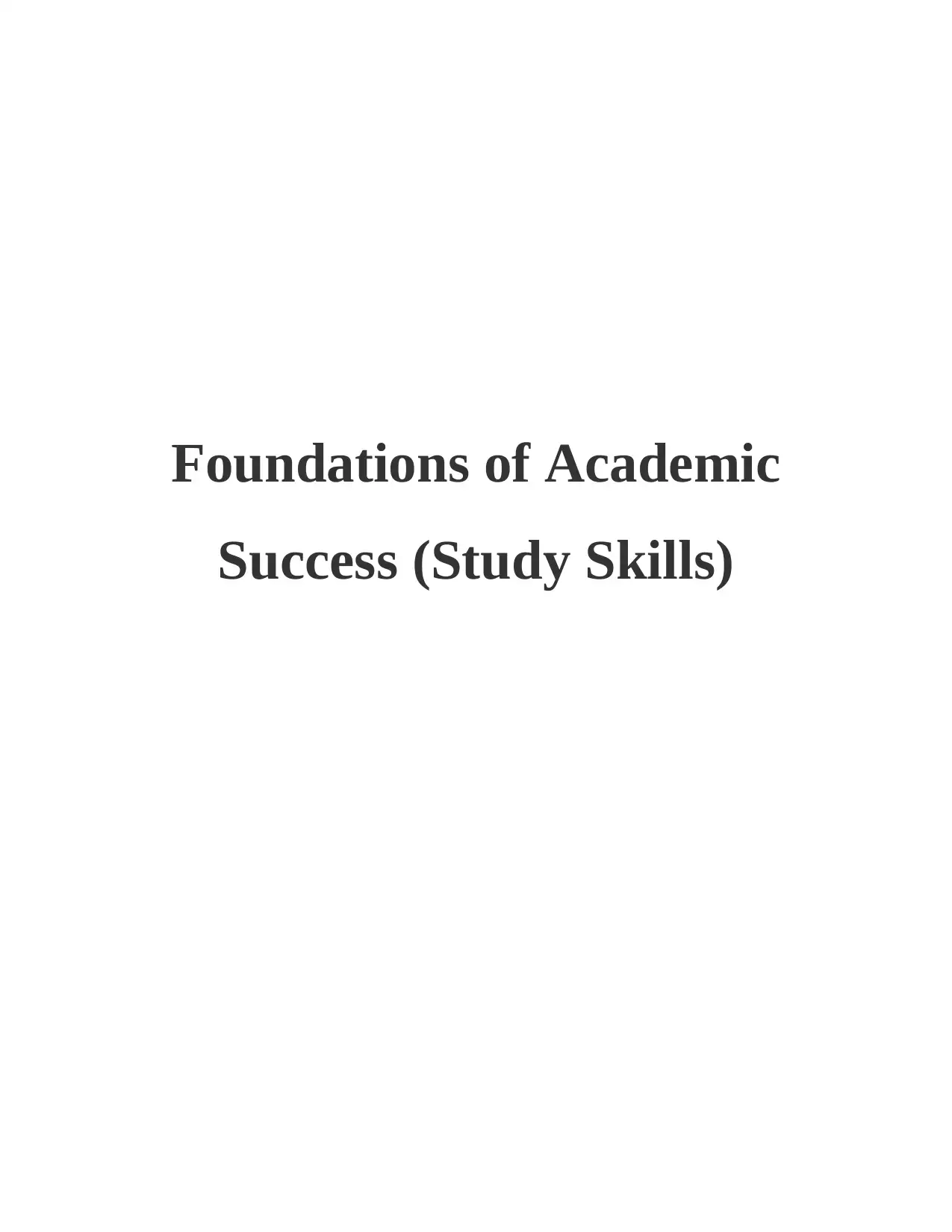
Foundations of Academic
Success (Study Skills)
Success (Study Skills)
Paraphrase This Document
Need a fresh take? Get an instant paraphrase of this document with our AI Paraphraser
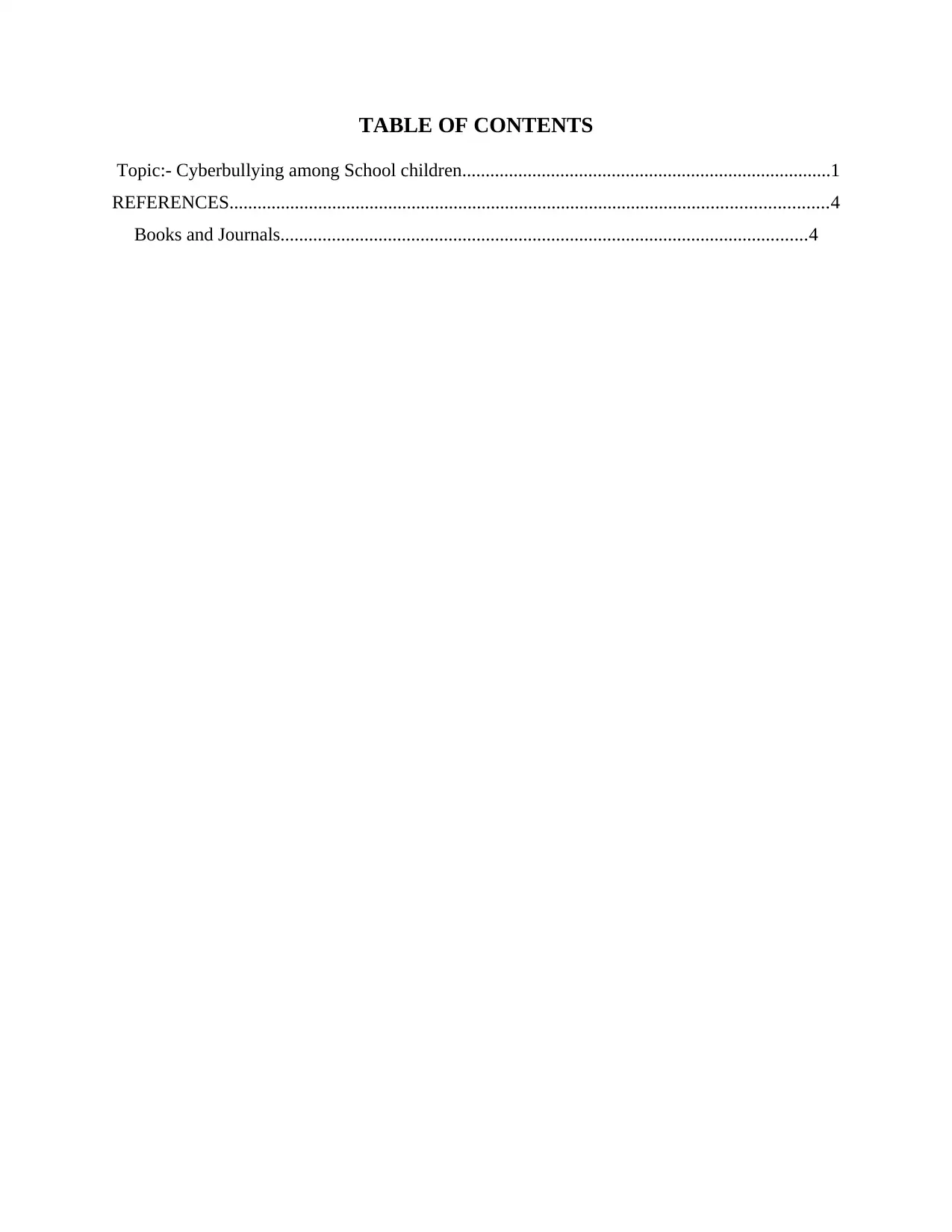
TABLE OF CONTENTS
Topic:- Cyberbullying among School children...............................................................................1
REFERENCES................................................................................................................................4
Books and Journals.................................................................................................................4
Topic:- Cyberbullying among School children...............................................................................1
REFERENCES................................................................................................................................4
Books and Journals.................................................................................................................4
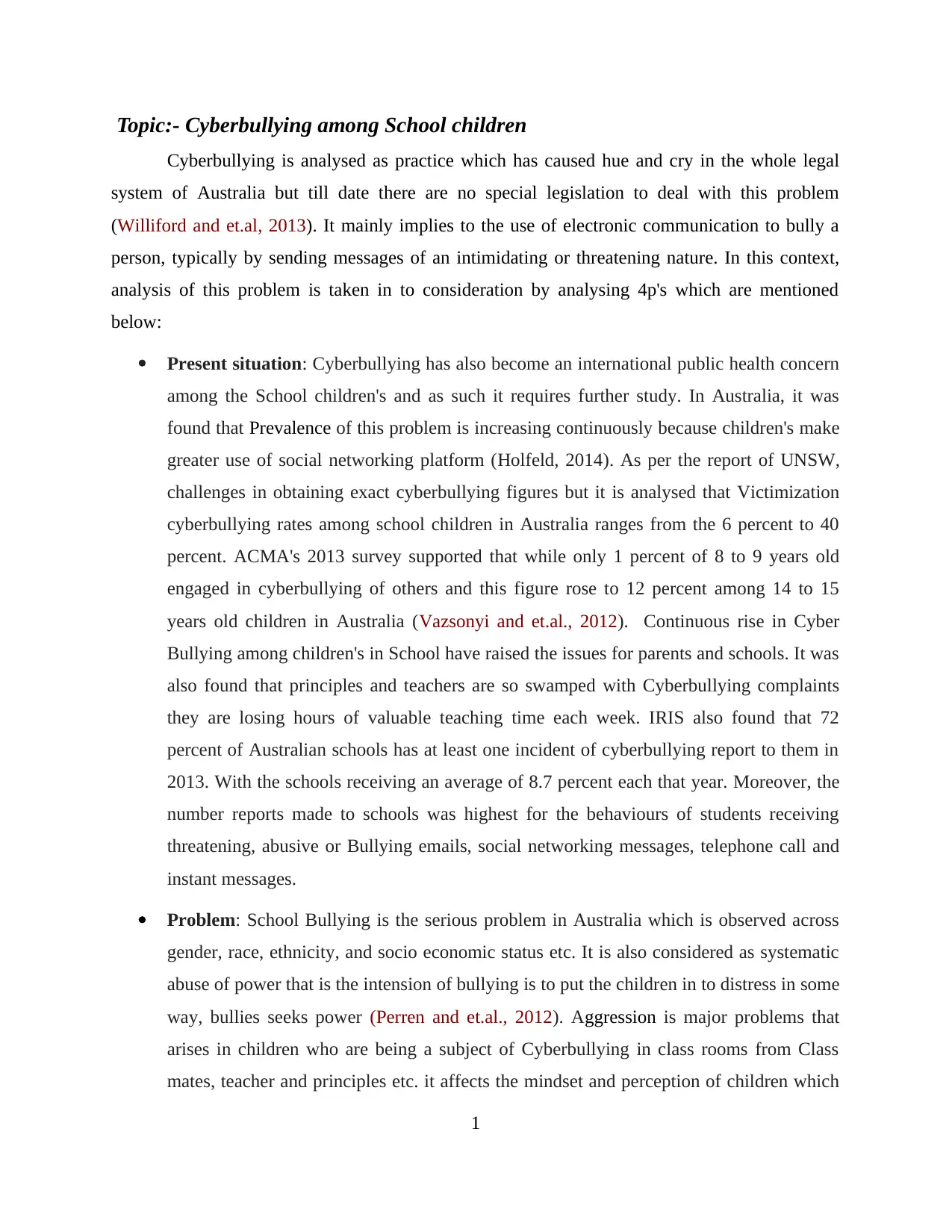
Topic:- Cyberbullying among School children
Cyberbullying is analysed as practice which has caused hue and cry in the whole legal
system of Australia but till date there are no special legislation to deal with this problem
(Williford and et.al, 2013). It mainly implies to the use of electronic communication to bully a
person, typically by sending messages of an intimidating or threatening nature. In this context,
analysis of this problem is taken in to consideration by analysing 4p's which are mentioned
below:
Present situation: Cyberbullying has also become an international public health concern
among the School children's and as such it requires further study. In Australia, it was
found that Prevalence of this problem is increasing continuously because children's make
greater use of social networking platform (Holfeld, 2014). As per the report of UNSW,
challenges in obtaining exact cyberbullying figures but it is analysed that Victimization
cyberbullying rates among school children in Australia ranges from the 6 percent to 40
percent. ACMA's 2013 survey supported that while only 1 percent of 8 to 9 years old
engaged in cyberbullying of others and this figure rose to 12 percent among 14 to 15
years old children in Australia (Vazsonyi and et.al., 2012). Continuous rise in Cyber
Bullying among children's in School have raised the issues for parents and schools. It was
also found that principles and teachers are so swamped with Cyberbullying complaints
they are losing hours of valuable teaching time each week. IRIS also found that 72
percent of Australian schools has at least one incident of cyberbullying report to them in
2013. With the schools receiving an average of 8.7 percent each that year. Moreover, the
number reports made to schools was highest for the behaviours of students receiving
threatening, abusive or Bullying emails, social networking messages, telephone call and
instant messages.
Problem: School Bullying is the serious problem in Australia which is observed across
gender, race, ethnicity, and socio economic status etc. It is also considered as systematic
abuse of power that is the intension of bullying is to put the children in to distress in some
way, bullies seeks power (Perren and et.al., 2012). Aggression is major problems that
arises in children who are being a subject of Cyberbullying in class rooms from Class
mates, teacher and principles etc. it affects the mindset and perception of children which
1
Cyberbullying is analysed as practice which has caused hue and cry in the whole legal
system of Australia but till date there are no special legislation to deal with this problem
(Williford and et.al, 2013). It mainly implies to the use of electronic communication to bully a
person, typically by sending messages of an intimidating or threatening nature. In this context,
analysis of this problem is taken in to consideration by analysing 4p's which are mentioned
below:
Present situation: Cyberbullying has also become an international public health concern
among the School children's and as such it requires further study. In Australia, it was
found that Prevalence of this problem is increasing continuously because children's make
greater use of social networking platform (Holfeld, 2014). As per the report of UNSW,
challenges in obtaining exact cyberbullying figures but it is analysed that Victimization
cyberbullying rates among school children in Australia ranges from the 6 percent to 40
percent. ACMA's 2013 survey supported that while only 1 percent of 8 to 9 years old
engaged in cyberbullying of others and this figure rose to 12 percent among 14 to 15
years old children in Australia (Vazsonyi and et.al., 2012). Continuous rise in Cyber
Bullying among children's in School have raised the issues for parents and schools. It was
also found that principles and teachers are so swamped with Cyberbullying complaints
they are losing hours of valuable teaching time each week. IRIS also found that 72
percent of Australian schools has at least one incident of cyberbullying report to them in
2013. With the schools receiving an average of 8.7 percent each that year. Moreover, the
number reports made to schools was highest for the behaviours of students receiving
threatening, abusive or Bullying emails, social networking messages, telephone call and
instant messages.
Problem: School Bullying is the serious problem in Australia which is observed across
gender, race, ethnicity, and socio economic status etc. It is also considered as systematic
abuse of power that is the intension of bullying is to put the children in to distress in some
way, bullies seeks power (Perren and et.al., 2012). Aggression is major problems that
arises in children who are being a subject of Cyberbullying in class rooms from Class
mates, teacher and principles etc. it affects the mindset and perception of children which
1
⊘ This is a preview!⊘
Do you want full access?
Subscribe today to unlock all pages.

Trusted by 1+ million students worldwide
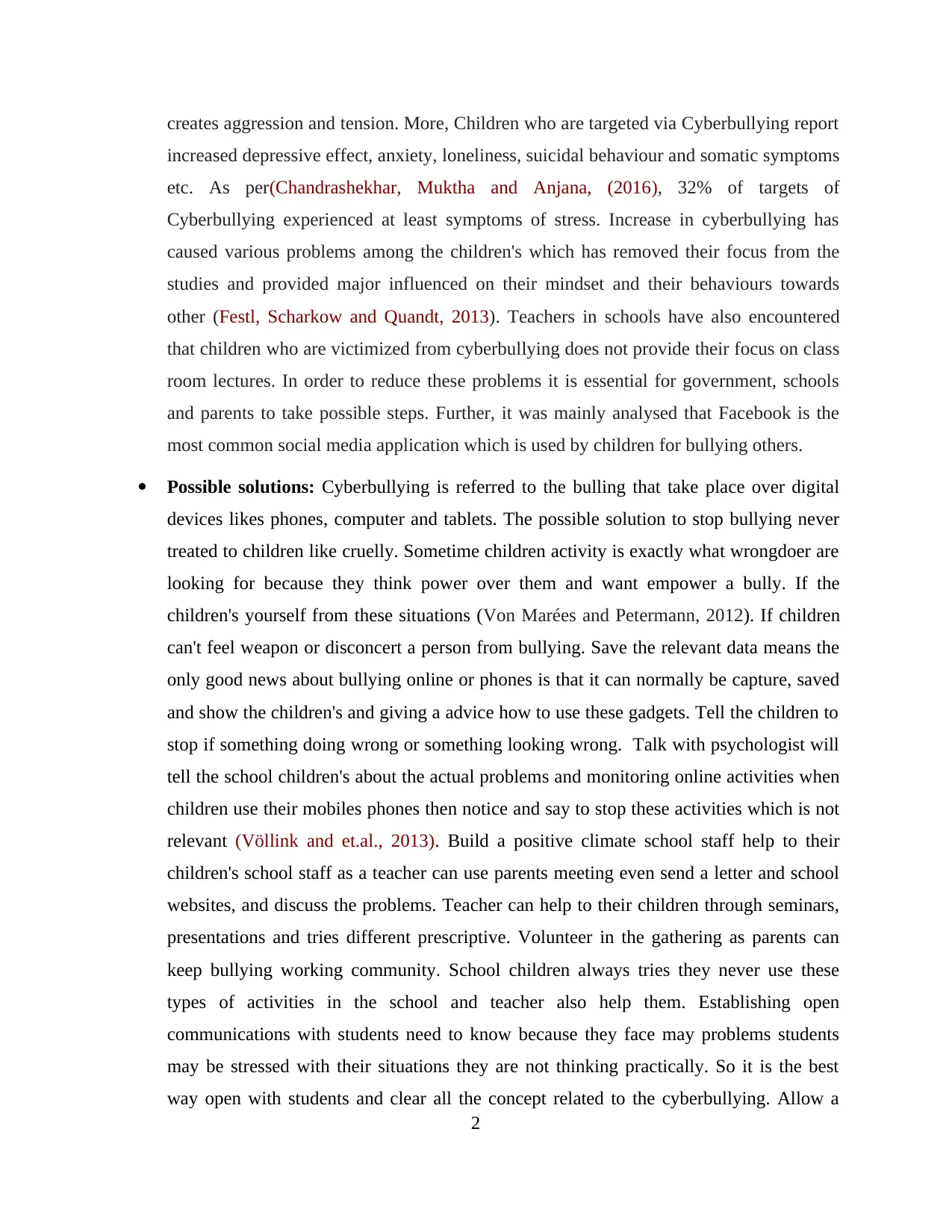
creates aggression and tension. More, Children who are targeted via Cyberbullying report
increased depressive effect, anxiety, loneliness, suicidal behaviour and somatic symptoms
etc. As per(Chandrashekhar, Muktha and Anjana, (2016), 32% of targets of
Cyberbullying experienced at least symptoms of stress. Increase in cyberbullying has
caused various problems among the children's which has removed their focus from the
studies and provided major influenced on their mindset and their behaviours towards
other (Festl, Scharkow and Quandt, 2013). Teachers in schools have also encountered
that children who are victimized from cyberbullying does not provide their focus on class
room lectures. In order to reduce these problems it is essential for government, schools
and parents to take possible steps. Further, it was mainly analysed that Facebook is the
most common social media application which is used by children for bullying others.
Possible solutions: Cyberbullying is referred to the bulling that take place over digital
devices likes phones, computer and tablets. The possible solution to stop bullying never
treated to children like cruelly. Sometime children activity is exactly what wrongdoer are
looking for because they think power over them and want empower a bully. If the
children's yourself from these situations (Von Marées and Petermann, 2012). If children
can't feel weapon or disconcert a person from bullying. Save the relevant data means the
only good news about bullying online or phones is that it can normally be capture, saved
and show the children's and giving a advice how to use these gadgets. Tell the children to
stop if something doing wrong or something looking wrong. Talk with psychologist will
tell the school children's about the actual problems and monitoring online activities when
children use their mobiles phones then notice and say to stop these activities which is not
relevant (Völlink and et.al., 2013). Build a positive climate school staff help to their
children's school staff as a teacher can use parents meeting even send a letter and school
websites, and discuss the problems. Teacher can help to their children through seminars,
presentations and tries different prescriptive. Volunteer in the gathering as parents can
keep bullying working community. School children always tries they never use these
types of activities in the school and teacher also help them. Establishing open
communications with students need to know because they face may problems students
may be stressed with their situations they are not thinking practically. So it is the best
way open with students and clear all the concept related to the cyberbullying. Allow a
2
increased depressive effect, anxiety, loneliness, suicidal behaviour and somatic symptoms
etc. As per(Chandrashekhar, Muktha and Anjana, (2016), 32% of targets of
Cyberbullying experienced at least symptoms of stress. Increase in cyberbullying has
caused various problems among the children's which has removed their focus from the
studies and provided major influenced on their mindset and their behaviours towards
other (Festl, Scharkow and Quandt, 2013). Teachers in schools have also encountered
that children who are victimized from cyberbullying does not provide their focus on class
room lectures. In order to reduce these problems it is essential for government, schools
and parents to take possible steps. Further, it was mainly analysed that Facebook is the
most common social media application which is used by children for bullying others.
Possible solutions: Cyberbullying is referred to the bulling that take place over digital
devices likes phones, computer and tablets. The possible solution to stop bullying never
treated to children like cruelly. Sometime children activity is exactly what wrongdoer are
looking for because they think power over them and want empower a bully. If the
children's yourself from these situations (Von Marées and Petermann, 2012). If children
can't feel weapon or disconcert a person from bullying. Save the relevant data means the
only good news about bullying online or phones is that it can normally be capture, saved
and show the children's and giving a advice how to use these gadgets. Tell the children to
stop if something doing wrong or something looking wrong. Talk with psychologist will
tell the school children's about the actual problems and monitoring online activities when
children use their mobiles phones then notice and say to stop these activities which is not
relevant (Völlink and et.al., 2013). Build a positive climate school staff help to their
children's school staff as a teacher can use parents meeting even send a letter and school
websites, and discuss the problems. Teacher can help to their children through seminars,
presentations and tries different prescriptive. Volunteer in the gathering as parents can
keep bullying working community. School children always tries they never use these
types of activities in the school and teacher also help them. Establishing open
communications with students need to know because they face may problems students
may be stressed with their situations they are not thinking practically. So it is the best
way open with students and clear all the concept related to the cyberbullying. Allow a
2
Paraphrase This Document
Need a fresh take? Get an instant paraphrase of this document with our AI Paraphraser
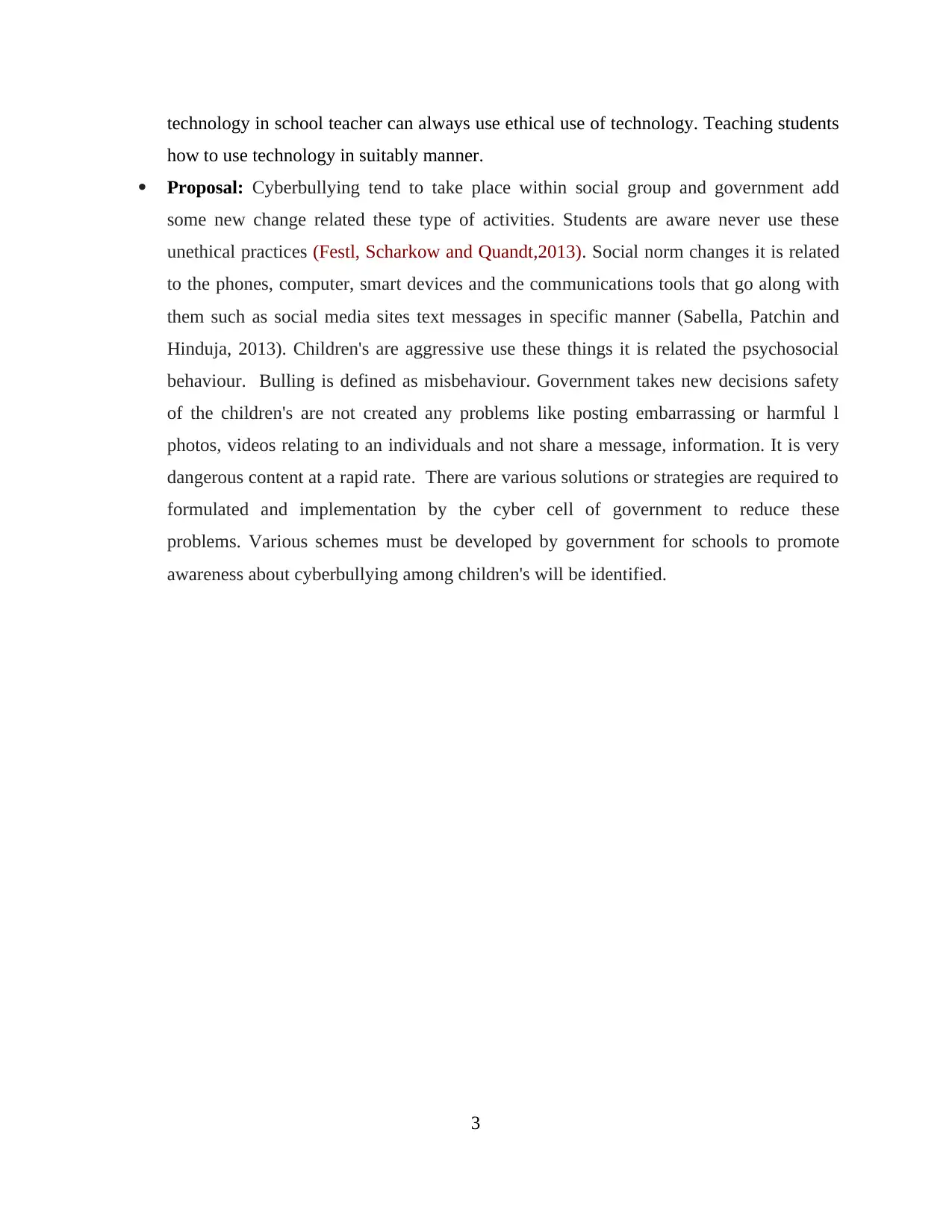
technology in school teacher can always use ethical use of technology. Teaching students
how to use technology in suitably manner.
Proposal: Cyberbullying tend to take place within social group and government add
some new change related these type of activities. Students are aware never use these
unethical practices (Festl, Scharkow and Quandt,2013). Social norm changes it is related
to the phones, computer, smart devices and the communications tools that go along with
them such as social media sites text messages in specific manner (Sabella, Patchin and
Hinduja, 2013). Children's are aggressive use these things it is related the psychosocial
behaviour. Bulling is defined as misbehaviour. Government takes new decisions safety
of the children's are not created any problems like posting embarrassing or harmful l
photos, videos relating to an individuals and not share a message, information. It is very
dangerous content at a rapid rate. There are various solutions or strategies are required to
formulated and implementation by the cyber cell of government to reduce these
problems. Various schemes must be developed by government for schools to promote
awareness about cyberbullying among children's will be identified.
3
how to use technology in suitably manner.
Proposal: Cyberbullying tend to take place within social group and government add
some new change related these type of activities. Students are aware never use these
unethical practices (Festl, Scharkow and Quandt,2013). Social norm changes it is related
to the phones, computer, smart devices and the communications tools that go along with
them such as social media sites text messages in specific manner (Sabella, Patchin and
Hinduja, 2013). Children's are aggressive use these things it is related the psychosocial
behaviour. Bulling is defined as misbehaviour. Government takes new decisions safety
of the children's are not created any problems like posting embarrassing or harmful l
photos, videos relating to an individuals and not share a message, information. It is very
dangerous content at a rapid rate. There are various solutions or strategies are required to
formulated and implementation by the cyber cell of government to reduce these
problems. Various schemes must be developed by government for schools to promote
awareness about cyberbullying among children's will be identified.
3
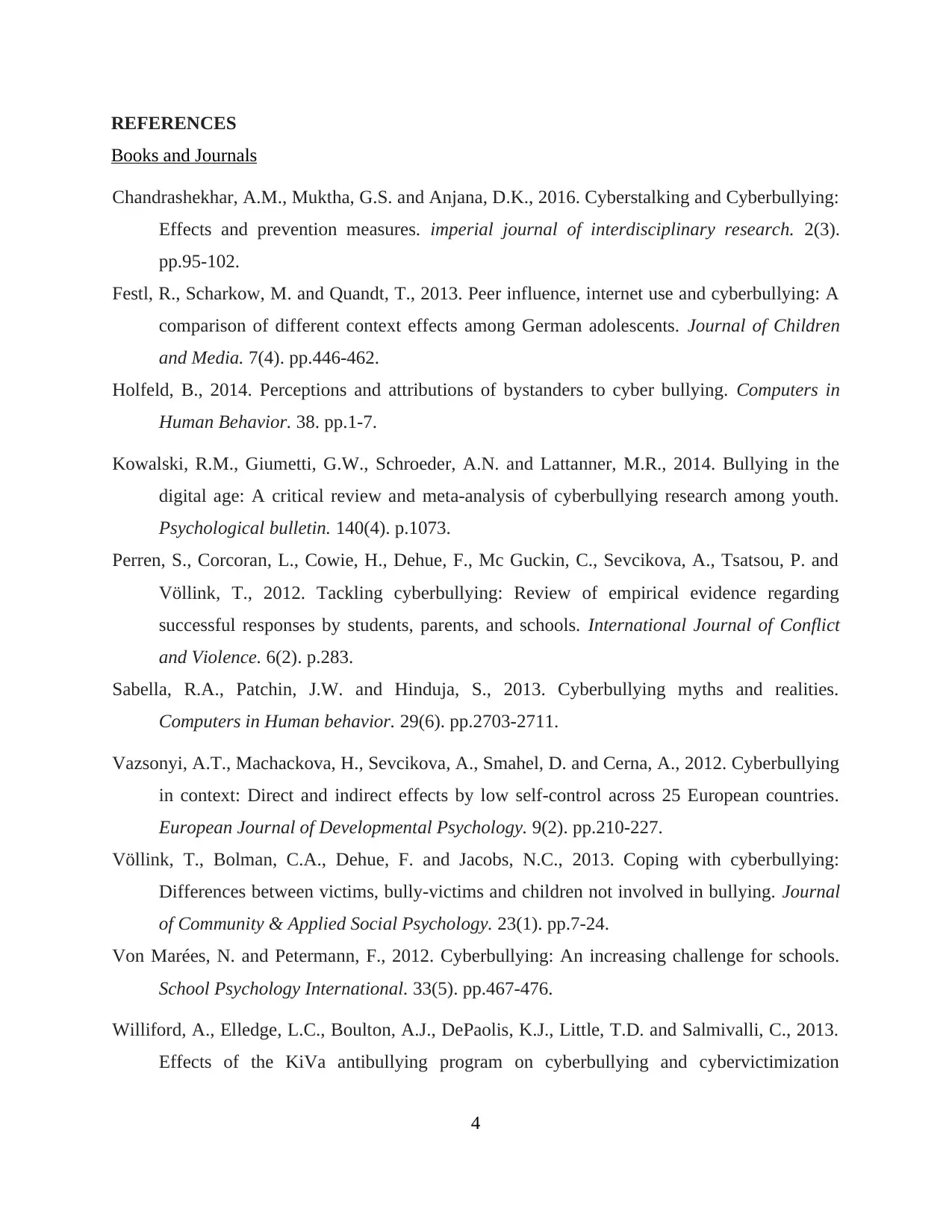
REFERENCES
Books and Journals
Chandrashekhar, A.M., Muktha, G.S. and Anjana, D.K., 2016. Cyberstalking and Cyberbullying:
Effects and prevention measures. imperial journal of interdisciplinary research. 2(3).
pp.95-102.
Festl, R., Scharkow, M. and Quandt, T., 2013. Peer influence, internet use and cyberbullying: A
comparison of different context effects among German adolescents. Journal of Children
and Media. 7(4). pp.446-462.
Holfeld, B., 2014. Perceptions and attributions of bystanders to cyber bullying. Computers in
Human Behavior. 38. pp.1-7.
Kowalski, R.M., Giumetti, G.W., Schroeder, A.N. and Lattanner, M.R., 2014. Bullying in the
digital age: A critical review and meta-analysis of cyberbullying research among youth.
Psychological bulletin. 140(4). p.1073.
Perren, S., Corcoran, L., Cowie, H., Dehue, F., Mc Guckin, C., Sevcikova, A., Tsatsou, P. and
Völlink, T., 2012. Tackling cyberbullying: Review of empirical evidence regarding
successful responses by students, parents, and schools. International Journal of Conflict
and Violence. 6(2). p.283.
Sabella, R.A., Patchin, J.W. and Hinduja, S., 2013. Cyberbullying myths and realities.
Computers in Human behavior. 29(6). pp.2703-2711.
Vazsonyi, A.T., Machackova, H., Sevcikova, A., Smahel, D. and Cerna, A., 2012. Cyberbullying
in context: Direct and indirect effects by low self-control across 25 European countries.
European Journal of Developmental Psychology. 9(2). pp.210-227.
Völlink, T., Bolman, C.A., Dehue, F. and Jacobs, N.C., 2013. Coping with cyberbullying:
Differences between victims, bully‐victims and children not involved in bullying. Journal
of Community & Applied Social Psychology. 23(1). pp.7-24.
Von Marées, N. and Petermann, F., 2012. Cyberbullying: An increasing challenge for schools.
School Psychology International. 33(5). pp.467-476.
Williford, A., Elledge, L.C., Boulton, A.J., DePaolis, K.J., Little, T.D. and Salmivalli, C., 2013.
Effects of the KiVa antibullying program on cyberbullying and cybervictimization
4
Books and Journals
Chandrashekhar, A.M., Muktha, G.S. and Anjana, D.K., 2016. Cyberstalking and Cyberbullying:
Effects and prevention measures. imperial journal of interdisciplinary research. 2(3).
pp.95-102.
Festl, R., Scharkow, M. and Quandt, T., 2013. Peer influence, internet use and cyberbullying: A
comparison of different context effects among German adolescents. Journal of Children
and Media. 7(4). pp.446-462.
Holfeld, B., 2014. Perceptions and attributions of bystanders to cyber bullying. Computers in
Human Behavior. 38. pp.1-7.
Kowalski, R.M., Giumetti, G.W., Schroeder, A.N. and Lattanner, M.R., 2014. Bullying in the
digital age: A critical review and meta-analysis of cyberbullying research among youth.
Psychological bulletin. 140(4). p.1073.
Perren, S., Corcoran, L., Cowie, H., Dehue, F., Mc Guckin, C., Sevcikova, A., Tsatsou, P. and
Völlink, T., 2012. Tackling cyberbullying: Review of empirical evidence regarding
successful responses by students, parents, and schools. International Journal of Conflict
and Violence. 6(2). p.283.
Sabella, R.A., Patchin, J.W. and Hinduja, S., 2013. Cyberbullying myths and realities.
Computers in Human behavior. 29(6). pp.2703-2711.
Vazsonyi, A.T., Machackova, H., Sevcikova, A., Smahel, D. and Cerna, A., 2012. Cyberbullying
in context: Direct and indirect effects by low self-control across 25 European countries.
European Journal of Developmental Psychology. 9(2). pp.210-227.
Völlink, T., Bolman, C.A., Dehue, F. and Jacobs, N.C., 2013. Coping with cyberbullying:
Differences between victims, bully‐victims and children not involved in bullying. Journal
of Community & Applied Social Psychology. 23(1). pp.7-24.
Von Marées, N. and Petermann, F., 2012. Cyberbullying: An increasing challenge for schools.
School Psychology International. 33(5). pp.467-476.
Williford, A., Elledge, L.C., Boulton, A.J., DePaolis, K.J., Little, T.D. and Salmivalli, C., 2013.
Effects of the KiVa antibullying program on cyberbullying and cybervictimization
4
⊘ This is a preview!⊘
Do you want full access?
Subscribe today to unlock all pages.

Trusted by 1+ million students worldwide

frequency among Finnish youth. Journal of Clinical Child & Adolescent Psychology.
42(6). pp.820-833.
5
42(6). pp.820-833.
5
1 out of 7
Related Documents
Your All-in-One AI-Powered Toolkit for Academic Success.
+13062052269
info@desklib.com
Available 24*7 on WhatsApp / Email
![[object Object]](/_next/static/media/star-bottom.7253800d.svg)
Unlock your academic potential
Copyright © 2020–2025 A2Z Services. All Rights Reserved. Developed and managed by ZUCOL.




